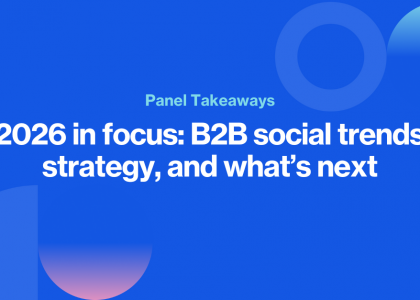When buyers are motivated by organic demand, they’re less likely to wander out of the sales funnel. But just because they are already interested in your brand doesn’t mean they don’t need your attention to turn into high-quality leads.
The average B2B buyer interacts with a brand 36 times before purchasing a product or service. Creating more opportunities for buyer-led engagement might be a better way to move buyers down the funnel than harvesting contact information so you can reach out with a sales pitch that may be premature.
And how do you create these opportunities? With a carefully crafted demand generation strategy that cost-effectively gets high-quality leads into your sales funnel.
What Does a Demand Generation Funnel Look Like?
A sales funnel visually represents the customer journey with a particular brand, starting from initial awareness (the Top of the Funnel, or TOFU) and ending with their final purchase (the Bottom of the Funnel, or BOFU). The funnel narrows as the buyer gets closer to a decision.
Demand generation aims at the broader audience near the top of the funnel. In contrast, traditional lead generation activities that respond to expressions of intent from the buyer are associated with the bottom of the funnel. A funnel focused on B2B demand generation aims to capture a broader customer base, create interest in your brand, nurture the audience, and ultimately get prospects to convert.
Why You Need a Demand Generation Funnel
Demand generation is the predominant TOFU strategy, and it is critical to initiating prospects into your funnel. Since your demand-generation activities will determine the content and experiences that form most customers’ first impressions of your brand, it can be helpful to think of it as the foundation on which all of the lower-in-the-funnel marketing initiatives are built.
A demand generation funnel can guide you to more efficient resource allocation, let you track your efforts and marketing investments, and build long-haul customer relationships. By monitoring results and customer feedback during this stage, you can obtain data-driven insights to improve customer engagement and lead conversion activities. You can also use your demand gen data to complete competitor analysis reports, effectively benchmarking your results against your top competitors.
Only 24% of CMOs say they have sufficient budget to execute their 2024 strategy. At times when marketers are being asked to do more with less and the endless complexity of the modern customer journey makes attribution more elusive than ever, demand generation is a cost-effective strategy.
It can be especially beneficial for B2B companies struggling with long sales cycles. By emphasizing TOFU content buyers can discover during their self-directed research, demand generation creates self-motivated leads that are easier to qualify and more likely to close, leading to shorter sojourns in the sales funnel and less chance of dropping out.
How to Build a Demand Generation Funnel for Your Company
A demand generation funnel should be a useful illustrative tool that supports your marketing team, not an artificial framework that hinders your workflow. Here are a few pointers you can follow to build a strong funnel and keep it in good shape:
1. Define Your Key Goals and Sales Targets
What is your company trying to achieve right now? Slow but steady growth? Customer retention? Your biggest sales month ever? The marketing strategies that support these goals are different, so starting with your objectives and building strategies around them, along with sales targets to measure your success, is essential.
2. Segment Your Audience
The effectiveness of marketing tactics depends on the behavior and demographics of the target audience. Gather customer data and segment your audience for more accurate and cost-effective targeting. Based on these segments, you can also develop customer personas to help you create personalized content.
3. Map Out Marketing Channels and Campaign Concepts
With your goals and target audience segments clearly defined, you can start mapping out ideas for demand-generation campaigns and selecting the best marketing channels to deliver them. In addition to paid ads, think about guest blogging, employee advocacy campaigns, video marketing, webinars, and other alternative and organic forms of outreach.
4. Draw on Real-World Examples
You can help your sales and marketing teams understand and execute demand generation concepts by rendering them in examples drawn from real-life experience. For instance, if you’re focusing on LinkedIn blogs, provide an example of a post that generated the kind of engagement you hope to elicit. Concrete examples can help move actual clients down the funnel when it comes time.
Marketing Strategies for Every Demand Generation Funnel Stage
The demand generation funnel can be subdivided into top, middle, and bottom stages. Depending on which stage leads are in, different marketing strategies will be required.
1. Top of the Funnel (TOFU)
TOFU is the mouth through which all customers enter the funnel. This stage is for prospects who are in the earliest stages of their purchasing journey and are learning about your brand for the first time.
Key Focus and Marketing Strategies to Implement
No prospect wants to be hit by a hard sell this early in the process—many of them will still be debating whether to purchase a particular solution and are far off from deciding who to buy it from if they do. Brand awareness is the top goal at this stage: making sure potential buyers know about your brand and that any associations they have with it are positive.
Success here often depends on ensuring that your ads or content are showing up regularly on the channels preferred by your target audience, so it can help a lot in managing your brand awareness campaigns with social media management platforms like Oktopost.
Keep your branding consistent across all your assets, including your website, social media channels, physical brochures, and other sales materials. Minor details, like adding a branded Hubspot email signature to your customer emails, can help establish brand consistency, build trust, and generate leads.
Key Metrics to Track for Top of the Funnel
Demand generation will reach many people who have no chance of becoming future customers. To evaluate such a broad approach, you can narrow your analytic focus. Count the number of marketing qualified leads (MQLs) who pass through this stage and calculate their cost by dividing your marketing spend by the total lead count.
2. Middle of the Funnel (MOFU)
Prospects who reach this funnel stage can be considered qualified leads: they’ve shown some interest, visited your website, and engaged with your brand on social media. They’re considering a purchase, and you’re in the running. However, it’s not a done deal yet, and they’re probably still checking out competitors.
Key Focus and Marketing Strategies to Implement
It’s common to end up with lots of MOFU leads and insufficient time to give them all personalized sales attention. Formula-based lead scoring can help you sort the most promising leads from the middling ones, making it easy to decide which ones to prioritize. At the same time, Oktopost and other marketing automation tools can help you nurture your leads with relevant content, retargeting, social proof, and other outreach methods that can keep them interested.
Key Metrics to Track for Middle of the Funnel
The MOFU stage should refine marketing-qualified leads into sales-qualified leads (SQLs) and help leads who aren’t a good fit decide to move on. Comparing the number of MQLs who made it through the last stage to the number of SQLs who made it through this one and calculating your cost per SQL may be the best way to determine whether it’s effectively carrying out these functions.
3. Bottom of the Funnel (BOFU)
The goal at the bottom of the funnel is to deliver whatever persuasive push is needed to get the lead to commit to a final decision to purchase from you. This is where your sales team gets to show off how great they are at closing deals.
Key Focus and Marketing Strategies to Implement
It’s time to pull out all the stops with personalized content, discovery calls, product trials, and in-person, hands-on demonstrations. Preparation is critical for success on discovery calls success, so ensure that your sales team leverages social listening and lead data to ask the right questions and best position your solution during the meeting.
Key Metrics to Track for Bottom of the Funnel
Check your BOFU performance by comparing sales figures to lead counts to see what percentage of leads turn into paying customers. At this point, you can also run metrics that evaluate the process as a whole, such as cost per acquisition.
Smart Tools Mean Faster Funnels
B2B marketing requires a multi-layered strategy designed to move prospective buyers down each sales funnel stage at the right time. The demand generation funnel can be a powerful component of this strategy, planting seeds of awareness and interest that will benefit future inbound marketing campaigns.
Across every stage of the funnel, tools like Oktopost can make it easier for your marketing efforts to bring about measurable results and improved ROI: spreading awareness at the top of the funnel with advanced social media management, engaging and nurturing leads at mid-funnel, and leveraging the insights from robust data analytics for bottom-of-the-funnel conversions. Sign up for a demo today to see what Oktopost can do to streamline and optimize your demand generation efforts.




